
A Guide to the EMS Product Range
1969 to 1979
by Graham Hinton
Last updated: 13 July 1996

Last updated: 13 July 1996
[Key to prices: (Price when introduced) 1979 Price]
London geography lesson: Peter Zinovieff lived in Putney, David Cockerell lived in Cricklewood, the BBC Radiophonic Workshop was located in Delaware Road and Portabello Road was (and still is) a fashionable market.
![]() VCS3 (aka The Putney)
VCS3 (aka The Putney)
1969. (£330)
Designer: David Cockerell.
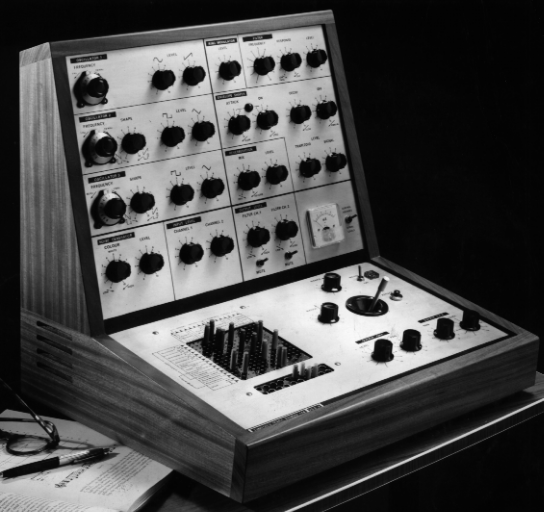
Very early VCS3 (pre-Putney), note Oscillator 1
The original portable synthesizer introduced in 1969. A solid Aformosia cabinet
housed the following modules interconnected by means of a matrix patchboard.
![]() VCS4
VCS4
1969. Not produced.
Designer: David Cockerell.
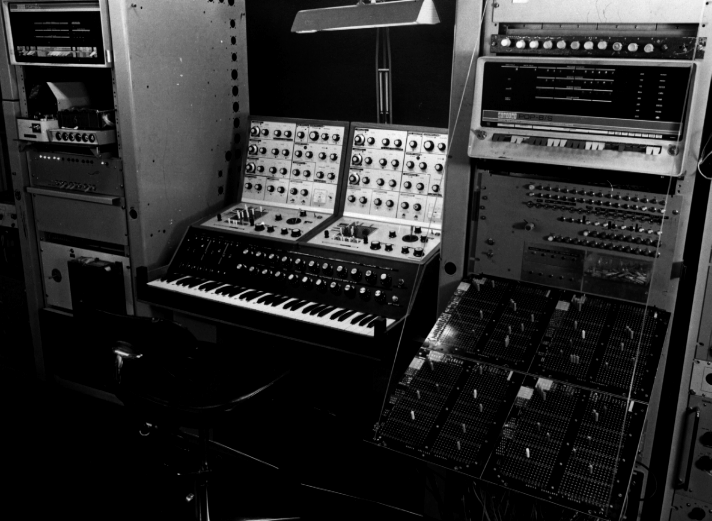
"Live Performance Module" comprising two VCS3s side by side with a keyboard in
front all in a single wooden cabinet. Only one prototype, last seen in 1983.
![]() DK1 (aka The Cricklewood)
DK1 (aka The Cricklewood)
1969. (£145)
Designer: David Cockerell.
Velocity sensitive "Dynamic" monophonic Keyboard for use with VCS3.
Included an extra VCO and VCA.
![]() Synthi KB1
Synthi KB1
1970. (£330) Not produced.
Designer: David Cockerell.
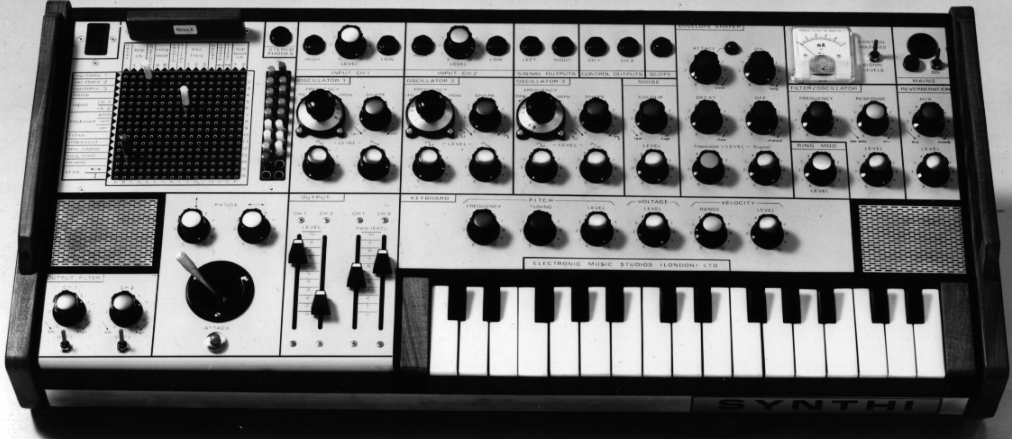
Same circuit modules as the VCS3 housed in a different case with a 29 note
miniature keyboard, Prototype sold to Yes.
![]() Synthi 100 (formerly Digitana, aka the
Delaware)
Synthi 100 (formerly Digitana, aka the
Delaware)
1971. (£6,500) £35,000
Designer: David Cockerell.
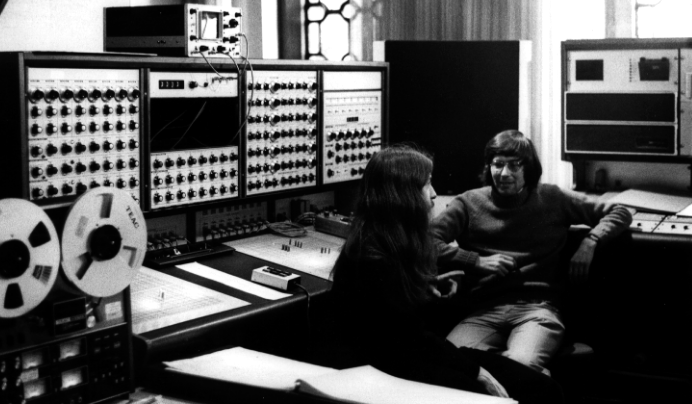
Synth100 (heavily modified) with Computer Synthi (1977)
Same technology as the VCS3, but built into a very large console patched with two 60 x 60 matrix boards, one for the signals and one for control voltages. Module complement:
Several of the devices were packaged separately as small wooden sleeved units:
![]() Sequencer 128 (also 32 and 64 versions)
Sequencer 128 (also 32 and 64 versions)
1971. (£135)

Prototype of what became the Sequencer 256
Peter Zinovieff and Tristam Cary walked into the Moog Trumansberg factory with
this and
just plugged it in, to much surprise and annoyance - their sequencer
could only do 8 steps.
![]() Synthi Sequencer 256 (formerly Synthi Moog
Sequencer)
Synthi Sequencer 256 (formerly Synthi Moog
Sequencer)
1971. (£1,100)
Designer: David Cockerell.
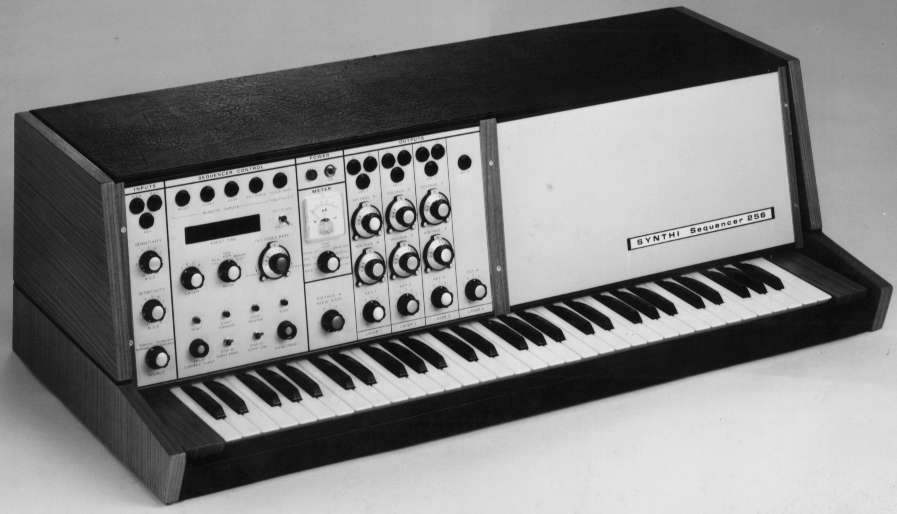
Separate version of the Synthi 100 sequencer.
![]() Synthi A (formerly Portabella)
Synthi A (formerly Portabella)
1971. (£198)
Designer: David Cockerell.
Same specification and pcbs as the VCS3, but fitted in an attache briefcase.
(Yes, it actually is a Spartanite one.)
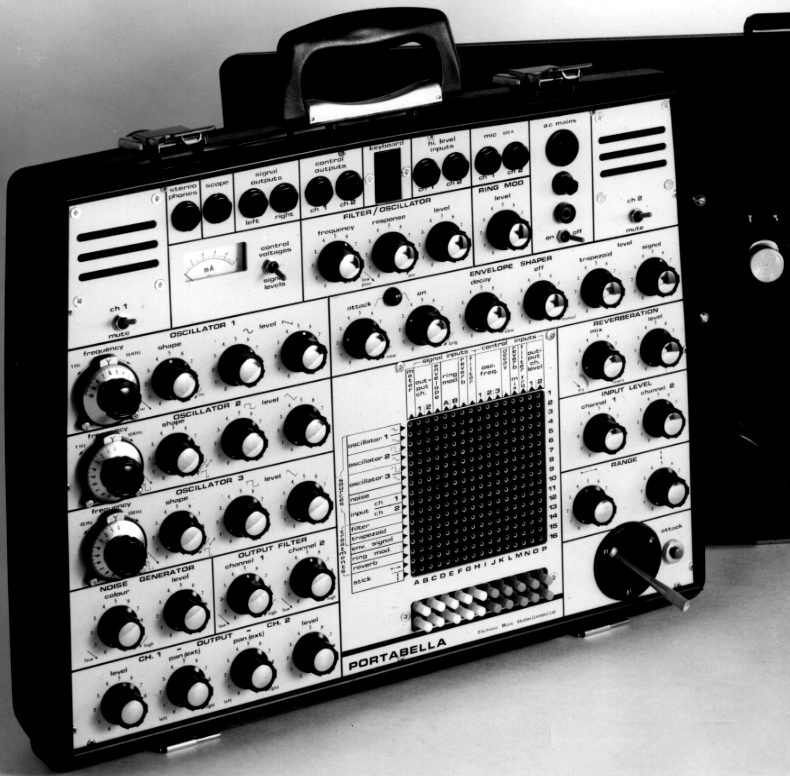
The prototype Synthi A. Note the name, the meter and the lid loudspeaker.
![]() Synthi AKS
Synthi AKS
1972. (£420) £1,452
Designer: David Cockerell.
Synthi A with a KS sequencer in the lid.

Synthi A with original KS and Sequencer32
The first 30 KS Sequencers featured a black and silver Touch pad,
Spin-and-touch random note selector and an unplayable resistive touch sensitive
keyboard. This was replaced by the familiar blue capacitive touch sensitive
keyboard layout.
![]() DK2
DK2
1972. (£145) £472
Designer: David Cockerell.
"Duophonic" version of DK1.
![]() DKS
DKS
1972. Not produced.
Designer: David Cockerell.
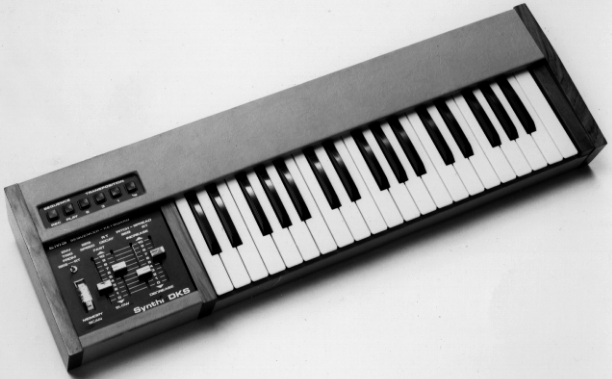
A mechanical keyboard version of the KS sequencer.
![]() KS
KS
1972. (£164)
Designer: David Cockerell.
The sequencer from the Synthi AKS available separately.
![]() Synthi Hi-Fli (formerly Sound Freak)
Synthi Hi-Fli (formerly Sound Freak)
1973. (£180) £308
Designer: David Cockerell.
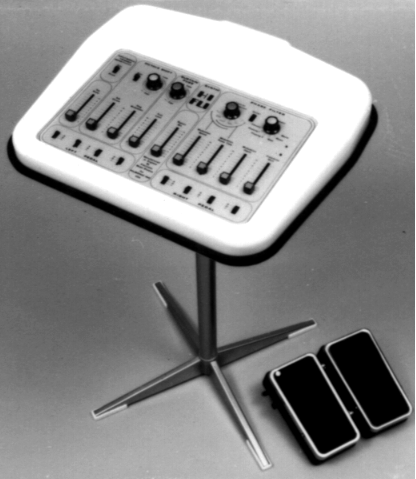
A guitar treatment unit built as a console on a stand with two pedal
controllers.
![]() Synthi VCS3 II
Synthi VCS3 II
1973. (£374) £1,268
Designer: David Cockerell.
Prestopatch added, matrix layout and some circuitry changed, otherwise same as
VCS3 Mk I.
![]() 32 x 32 Matrix
32 x 32 Matrix
1974. (£450)
Designer: David Cockerell.
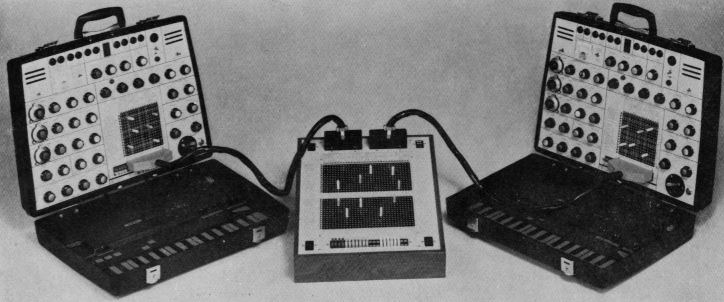
Patchboard for interconnecting two VCS3s or Synthi As by plugging into the
Prestopatch sockets.
![]() 49 x 49 Matrix
49 x 49 Matrix
1974. (£583)
Designer: David Cockerell.
Larger version of above with keyboard sockets.
![]() Synthi P
Synthi P
1974. Not produced.
Designer: David Cockerell.
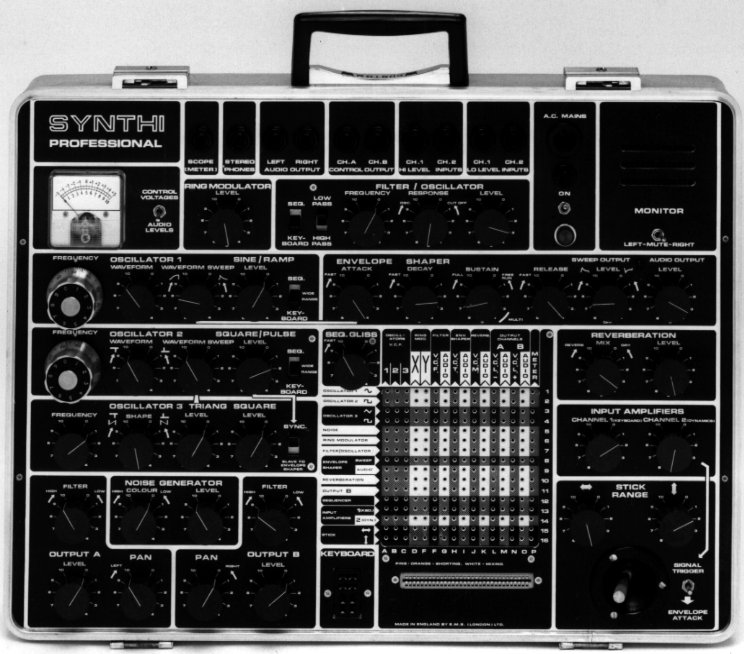
A MkIII "Professional" version with improved Oscillators, Filter and
Envelope.
Only 3 prototypes made, 2 in this form with bronze finish, the other in
standard Synthi A case and styling.
![]() Speech Synthesizer
Speech Synthesizer
1974. Not produced.
Designer: David Cockerell.
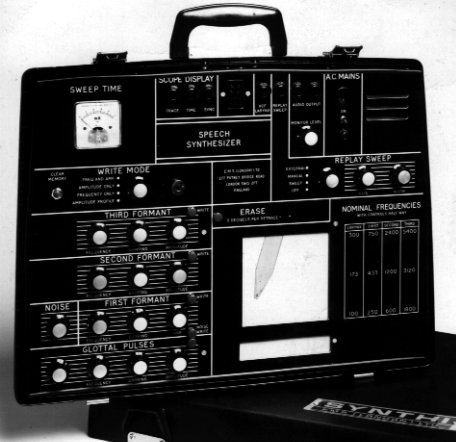
Prototype with graphic Formant entry (drawn with a biro!).
![]() Spectron (formerly Spectre)
Spectron (formerly Spectre)
1974/5. (£4,000)
Designer: Richard Monkhouse.
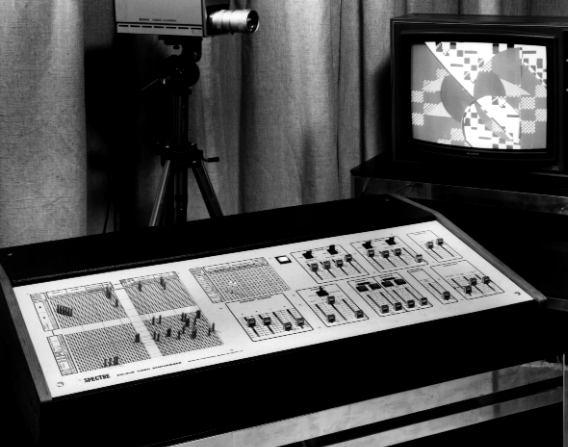
Innovative Video Synthesiser using analogue and digital techniques.
![]() Computer Synthi
Computer Synthi
1975/6. (£15,000, software extra)
Designer: Peter Eastty.
An add-on to the Synthi 100 interfaced to the control matrix board via two 24 x
60 matrix boards. Complement:
![]() Synthi E
Synthi E
1975. (£200) £558
Designer: Tim Orr
A low cost "Educational" synthesizer in briefcase format.
![]() Synthi DKE
Synthi DKE
1975. £200
Designer: Tim Orr
A 3 octave mechanical keyboard for Synthi E.
![]() QUEG - Quadrophonic Effects Generator
QUEG - Quadrophonic Effects Generator
1975. (£1400)
Designer: Tim Orr.
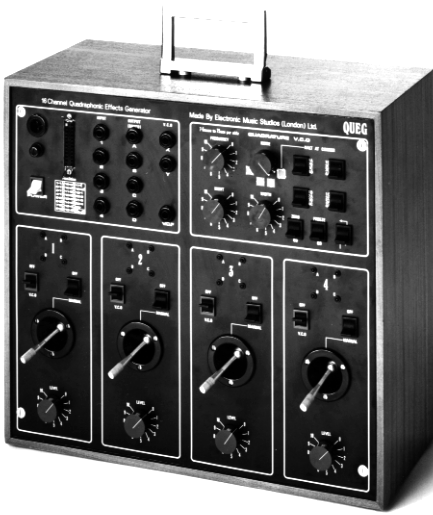
Four channel quad surround sound mixer with joystick and quadrature VCO
control. A two channel version was also made fitted into a custom Electrosonic
EMS Mixing Console.
![]() Phase Frequency Shifter
Phase Frequency Shifter
1975. (£400).
Designer: Tim Orr.
Separate version of the one in the Vocoder 5000.
![]() Vocoder 5000 (aka Studio Vocoder)
Vocoder 5000 (aka Studio Vocoder)
1976 (£5,000) £7,165
Designer: Tim Orr.

Custom version built into Synthi 100 for WDR Germany (Stockhausen)
![]() Universal Sequencer
Universal Sequencer
1977. (£700)
Designer: Tim Orr.
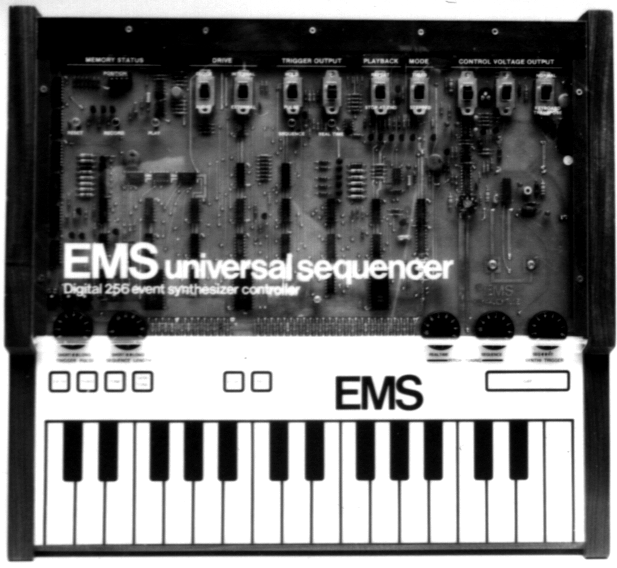
Upgraded KS with Control Voltage and Gate interface.
Few built.
![]() Vocoder 2000
Vocoder 2000
1977. £813
Designer: Tim Orr.
![]() VCS3/Synthi A Upgrade Cards
VCS3/Synthi A Upgrade Cards
1978. Not produced.
Designer: Graham Hinton.
Replacement circuit boards featuring improved VCOs with temperature
compensation and synchronisation, improved VCAs, RM and Reverb.
![]() PolySynthi
PolySynthi
1978. (£700) £1,200
Designer: Graham Hinton.
![]() PolySequencer
PolySequencer
1978. Not produced.
Designers: Peter Zinovieff and Graham Hinton.

Microprocessor based polyphonic sequencer with up to 10 minutes recording
capacity.
Real time editing and effects.
2 prototypes built.
Go to EMS Main Page
Go to EMS Modifications
Page
All material on these pages Copyright ©1995, 1996 Graham Hinton.
Synthi is a trademark of Electronic Music Studios.
Photos by permission of Robin Wood.
All manufacturers' trademarks are acknowledged.